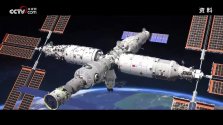You are using an out of date browser. It may not display this or other websites correctly.
You should upgrade or use an alternative browser.
You should upgrade or use an alternative browser.
China's Space Program Thread II
- Thread starter Blitzo
- Start date
AssassinsMace
Lieutenant General
I saw Bill Nelson being interviewed on TV this morning and he mentions rivalries in space. He mentions Russia as a rival but he makes no mention of China. He makes no mention of how water on the moon is the US's God-given right and not China's. He must've got the memo to shut up!
I notice that in the screen shot the guidepost in the docking hub says "Tianhe core module NO.1". I think this is a clear evidence that "Tianhe core module NO.2" is already in China's space station plan.View attachment 113620
That's because two Tianhe core modules were originally built. Tianhe no. 2 was meant as a back-up in case the first Tianhe launch failed.
There was an early study/plan to have a dual-Tianhe, six-module config as part of the CSS expansion plan, but thus far the only tentative 'plan' on future expansions has been the MFM, at least for now -

by78
General
The rarely seen locking arms (yellow arrows in 1st image and in purple in 2nd image) that quickly attach Shenzhou-16 spacecraft to the payload fairing in the event of launch failure. The payload fairing is an integral part of the launch escape system and to which the escape tower and control grid fins are attached. During normal launch mode, the spacecraft is not secured to the payload fairing, but during an emergency, the arms quickly and securely attach the spacecraft to the fairing just before the fairing detaches from the rest of the rocket and the escape tower fires to safely steer the payload fairing –– with the spacecraft attached –– away from the failing rocket.






The rarely seen locking arms (yellow arrows in 1st image and in purple in 2nd image) that quickly attach Shenzhou-16 spacecraft to the payload fairing in the event of launch failure. The payload fairing is an integral part of the launch escape system and to which the escape tower and control grid fins are attached. During normal launch mode, the spacecraft is not secured to the payload fairing, but during an emergency, the arms quickly and securely attach the spacecraft to the fairing just before the fairing detaches from the rest of the rocket and the escape tower fires to safely steer the payload fairing –– with the spacecraft attached –– away from the failing rocket.



How fast are those arms? What would be the disadvantage in having them always attached during launch and then detaching after jettisoning the escape tower. Wouldn't that allow for a quicker escape during an emergency?
by78
General
How fast are those arms? What would be the disadvantage in having them always attached during launch and then detaching after jettisoning the escape tower. Wouldn't that allow for a quicker escape during an emergency?
It's not a good idea to secure the payload to the fairing because vibrations from during launch can be very harsh.
by78
General
The Shenzhou-15 crew has vacated the space station and entered the return capsule in preparation for their return to Earth. The re-entry is scheduled for around 4 AM Beijing Time.
The Shenzhou-15 crew broke multiple Chinese records, including the longest flight duration (186 days and 7.4 hours) and longest stay in space (185 days 15 hours and 47 minutes).



The Shenzhou-15 crew broke multiple Chinese records, including the longest flight duration (186 days and 7.4 hours) and longest stay in space (185 days 15 hours and 47 minutes).






